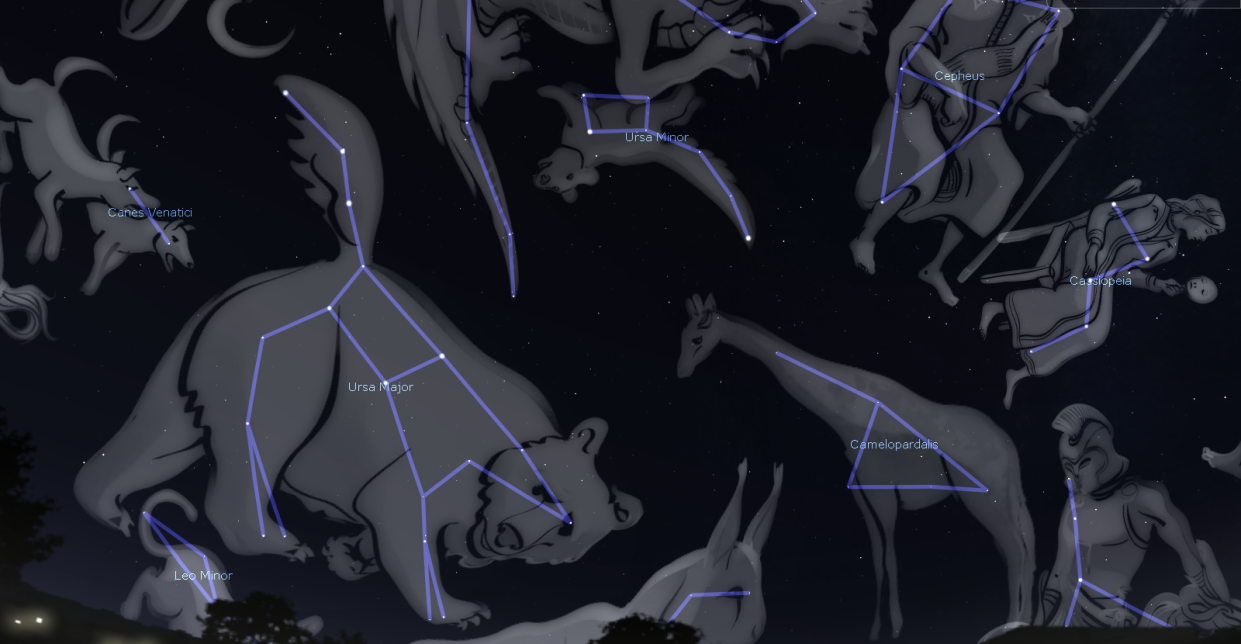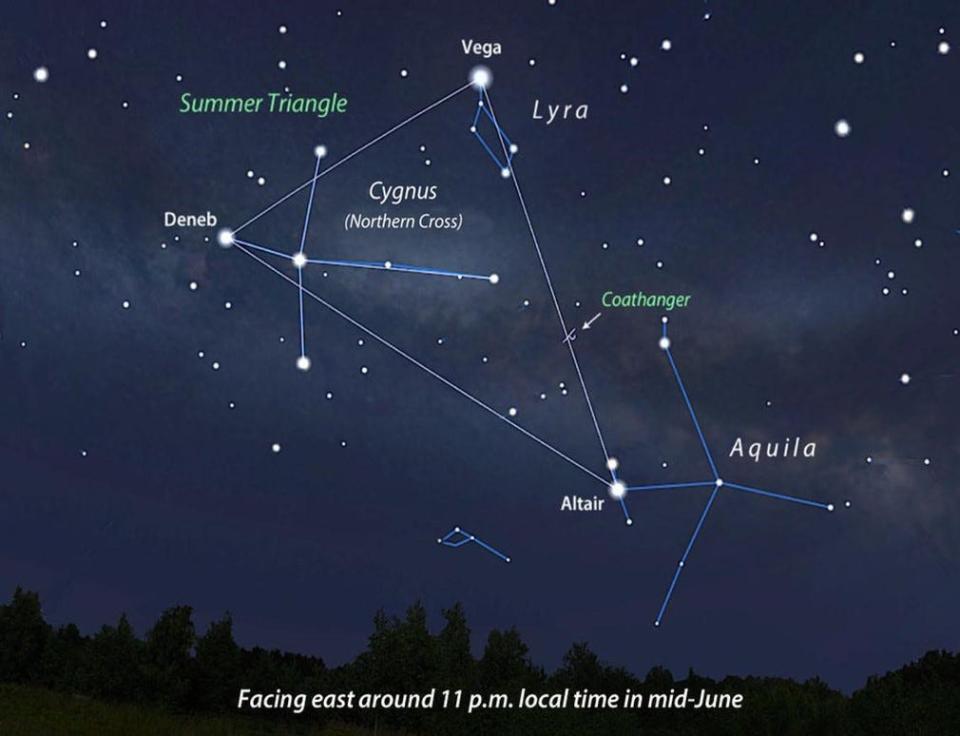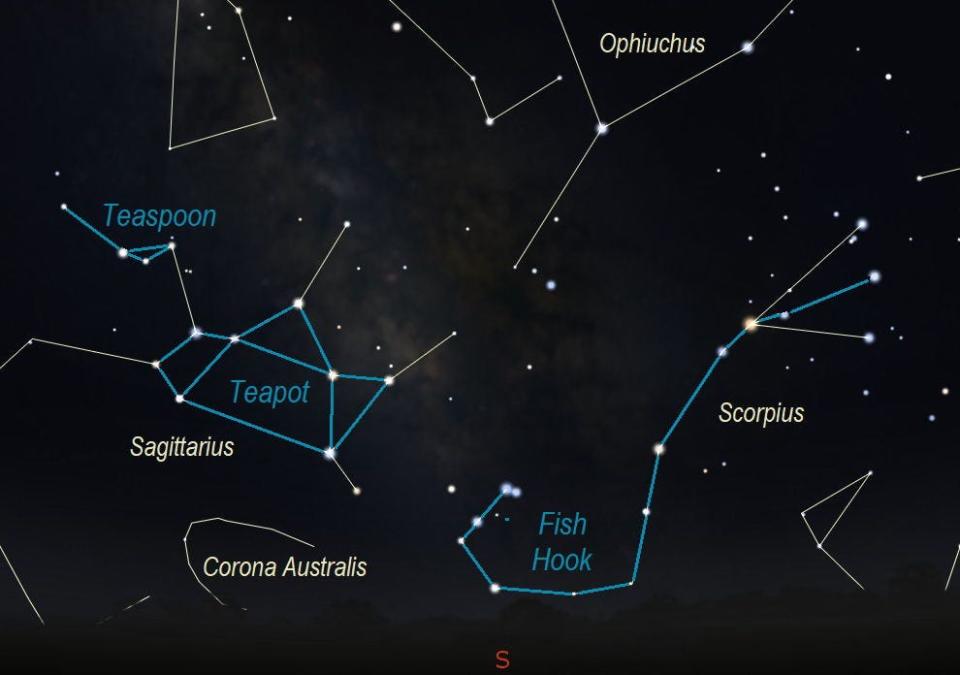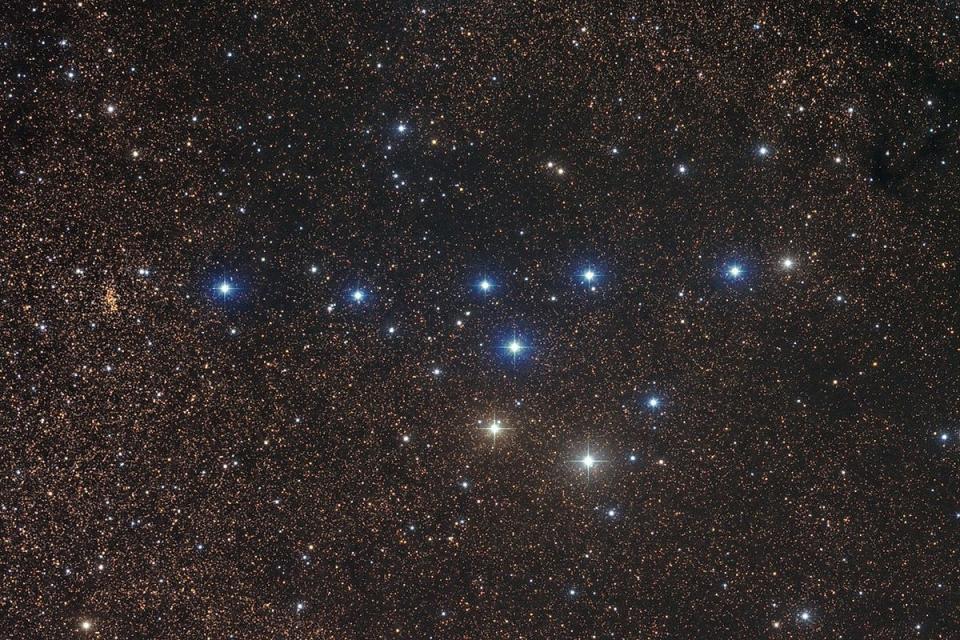Sky Shorts: Dig deeper into night skies with summer asterisms

August is a great month to enjoy a night under the stars.
It has always been my favorite. The nights are warm, the sun sets earlier and there are still a few weeks until school starts.
It is always enjoyable to find constellations, but have you explored asterisms? Constellations are patterns of stars that are bounded by borders designated by the International Astronomical Union. There are 88 official constellations, 48 date back to ancient civilizations. Asterisms are fairly new and are patterns of stars with shapes and sizes more easily recognized. They most often are smaller and less overwhelming than constellations and provide simpler guides to navigate the night sky, especially for beginners.
Let’s start in the northwest, where we find the most well known asterism, the Big Dipper.
Find the two stars at the end of the cup of the Big Dipper and draw an imaginary line to the next bright star, which is the North Star, which also is the tip of the handle of the Little Dipper, another asterism.
These two groups of stars are a part of the constellations, Ursa Major, the Big Bear, and Ursa Minor, the Little Bear. The “W” shape below and to the right of the dippers is an asterism that is part of the constellation, Cassiopeia.

Looking east, it is easy to spot three bright stars, Vega, Deneb and Altair. If you connect these three stars they form a triangle, the Summer Triangle. This asterism spans three different constellations, Lyra, the Harp; Cygnus, the Swan; and Aquilla, the Eagle.
The next asterism requires binoculars. A third of the way from the star Altair to the star Vega you will spot an upside-down coat hanger, therefore called the Coathanger.
Heading toward the south, the Teapot pattern is part of the constellation Sagittarius and the Fish Hook pattern is part of Scorpius. If you have dark skies in your neighborhood, you may see the Milky Way draped across the sky from north to south. The Milky Way can be seen in between the Teapot and the Fish Hook. Sometimes it is referred to as steam coming out of the Teapot!
Constellation-based asterisms, which are the most recognized part of their host constellation would be the Big and Little Dipper, the “W” in Cassiopeia, the Fish Hook in Scorpius and the Teapot in Sagittarius.
So, head out on the next clear night and see how many asterisms you can find!

Night Sky for August
It is time, once again, for one of the best meteor showers of the year – the Perseid Meteor Shower, on Aug. 12-13. This year it will be affected by the full moon. The bright moonlight will fade all but the brightest meteors. The Perseids are active from July 17 to Aug. 24, so best time to look, this year, may be a week before Aug. 12 or a few days after. The Perseids radiate from the constellation Perseus, which rises in the northeast around midnight, but you can expect to see some starting around 10 pm. So, grab that lawn chair or blanket, family and friends and look towards the northeast, especially after midnight!
Planets and the Moon – The two visible gas giant planets steal the show for our August nights. Saturn rises in the east around 9 p.m. on Aug. 1 and reaches opposition on Aug. 14, so it is visible from dusk to dawn. Saturn brightens to magnitude 0.2 and is the brightest object in the southeastern sky. The full moon of August lies within 5 degrees of golden-colored Saturn on the night of Aug. 11-12. Brilliant Jupiter rises in the hour before midnight on Aug. 1 and before 9 p.m. by Aug. 31. Neptune starts the month in southwestern Pisces and can be found by looking 13.5 degrees south of Jupiter, binoculars will be needed. Mars and Uranus rise together in Aries soon after midnight on Aug. 1. Reddish Mars will be easy to find, shining at magnitude 0.2. Uranus is harder to locate but lies 1.4 degrees north of Mars, binoculars will be needed. The Moon will pass 4 degrees north of Uranus the morning of Aug. 18. Mars will move eastward into Taurus on Aug. 9; 6 degrees south of the Pleaides between Aug. 16-19; and then stands 5.7 degrees northwest of the bright star Aldebaran on Aug. 31. Aldebaran is similar in color to Mars. Venus is dazzling in the morning sky all month. On Aug. 17, Venus will be less than a degree west of the Beehive Cluster, a nice sight in binoculars. Mercury hugs the western horizon all month at sunset. On Aug. 3, Mercury will be less than one degree north of the bright star, Regulus, binoculars work best. The Moon enters the scene and Mercury lies 9.5 degrees left of the Moon on Aug. 28, and 6.5 degrees below on Aug. 29. Once again, binoculars will work best for spotting Mercury. Other Moon passings include south of Jupiter on Aug. 15, and north of Mars on Aug. 19.
Constellations
West – Look for a bright yellow, orange star, which is Arcturus. Above Arcturus is a semi-circle of stars, the Northern Crown or Corona Borealis. Continuing up, you will see a keystone or crooked square shape, which is the body of Hercules.
North – The Big Dipper continues to swing down in the northwestern sky. Following the two stars at the end of the cup to the next bright star, Polaris, or the North Star. The constellation Cassiopeia, the “W” shape is below Polaris.
East – The bright blue, white star is Vega. Down and to the left is Deneb and continuing to the right is Altair. When you connect these three bright stars you have made the Summer Triangle. Now head back to Deneb, imagine this to be the tail of Cygnus, the Swan. To the right will be three stars in a line. These would be the outstretched wings. Extending from the wings would be the long neck and head of the swan. The head of Cygnus is a double star, Albireo.
South – Look for the red, orange star, Antares, which is the heart of Scorpius. To the left of Scorpius is the shape of a teapot. The stars of the teapot are part of the constellation Sagittarius.
Binocular highlights – Find Hercules and scan around the part of Hercules that faces Corona Borealis. You will see a fuzzy object which is the finest globular star cluster in the northern skies! Starting inside the Summer Triangle, scan right, all the way to the left of Antares, in the southern sky and left to Cassiopeia in the northern sky. You will see an abundance of stars which are part of our Milky Way galaxy! Don’t forget the Coathanger asterism by scanning off our Summer Triangle star, Altair.
For further night sky details, maps and audio, visit my website www.starrytrails.com.

Visit the Hoover Price Planetarium
There will be daily planetarium shows Tuesday through Saturday, through Sept. 5. Visit www.mckinleymuseum.org. Planetarium shows are free with museum admission. Seating is limited and will be on a first-come, first-serve basis. The planetarium is located inside the McKinley Presidential Library & Museum, 800 McKinley Monument Drive NW in Canton. For more information, call the museum at 330-455-7043.

This article originally appeared on The Repository: Sky Shorts: Dig deeper into night skies with summer asterisms

